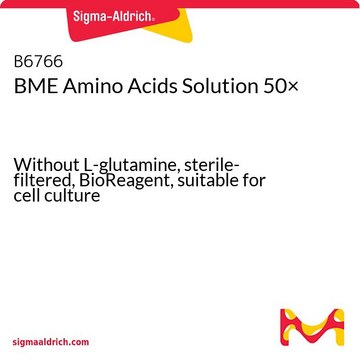R7131
RPMI 1640 Amino Acids Solution (50×)
Without L-glutamine, sterile-filtered, BioReagent, suitable for cell culture
Sinônimo(s):
Amino Acid Supplement
Faça loginpara ver os preços organizacionais e de contrato
About This Item
Código UNSPSC:
12352209
NACRES:
NA.75
Produtos recomendados
Nível de qualidade
esterilidade
sterile-filtered
linha de produto
BioReagent
Formulário
liquid
técnica(s)
cell culture | mammalian: suitable
Impurezas
endotoxin, tested
Condições de expedição
ambient
temperatura de armazenamento
2-8°C
Descrição geral
RPMI 1640 Amino Acids Solution (50×) serves as an amino acid concentrate to supplement Roswell Park Memorial Institute medium (RPMI)-based mammalian cell culture media.
Aplicação
RPMI 1640 Amino Acids Solution (50×) has been used as a supplement:
- in M9 minimal medium to culture the bacterial strains, SX701 and JE116
- to culture blood neutrophils from lactation cows in vitro
- for amino acid stimulation in amino-acid-free Roswell Park Memorial Institute medium (RPMI) medium to grow HeLa cells
Código de classe de armazenamento
10 - Combustible liquids
Classe de risco de água (WGK)
WGK 1
Ponto de fulgor (°F)
Not applicable
Ponto de fulgor (°C)
Not applicable
Escolha uma das versões mais recentes:
Já possui este produto?
Encontre a documentação dos produtos que você adquiriu recentemente na biblioteca de documentos.
Os clientes também visualizaram
Nuno Carinhas et al.
BMC systems biology, 5, 34-34 (2011-03-01)
Stoichiometric models constitute the basic framework for fluxome quantification in the realm of metabolic engineering. A recurrent bottleneck, however, is the establishment of consistent stoichiometric models for the synthesis of recombinant proteins or viruses. Although optimization algorithms for in silico
D Kazyken et al.
The Journal of biological chemistry, 297(4), 101100-101100 (2021-08-22)
The mechanistic target of rapamycin (mTOR) complex 2 (mTORC2) signaling controls cell metabolism, promotes cell survival, and contributes to tumorigenesis, yet its upstream regulation remains poorly defined. Although considerable evidence supports the prevailing view that amino acids activate mTOR complex
Preeti Ashok et al.
Frontiers in bioengineering and biotechnology, 8, 571425-571425 (2020-11-17)
Functional heart cells and tissues sourced from human pluripotent stem cells (hPSCs) have great potential for substantially advancing treatments of cardiovascular maladies. Realization of this potential will require the development of cost-effective and tunable bioprocesses for manufacturing hPSC-based cell therapeutics.
Piero Dalle Pezze et al.
Nature communications, 7, 13254-13254 (2016-11-22)
Amino acids (aa) are not only building blocks for proteins, but also signalling molecules, with the mammalian target of rapamycin complex 1 (mTORC1) acting as a key mediator. However, little is known about whether aa, independently of mTORC1, activate other
Daniel Bloch Hansen et al.
The Journal of membrane biology, 245(2), 77-87 (2012-03-03)
The present work was initiated to investigate regulation of the taurine transporter TauT by reactive oxygen species (ROS) and the tonicity-responsive enhancer binding protein (TonEBP) in NIH3T3 mouse fibroblasts during acute and long-term (4 h) exposure to low-sodium/hypo-osmotic stress. Taurine
Nossa equipe de cientistas tem experiência em todas as áreas de pesquisa, incluindo Life Sciences, ciência de materiais, síntese química, cromatografia, química analítica e muitas outras.
Entre em contato com a assistência técnica









